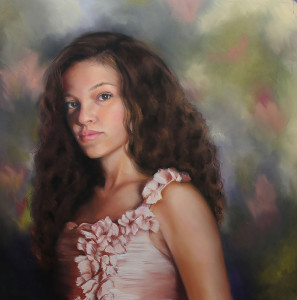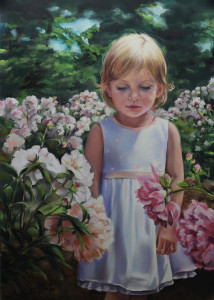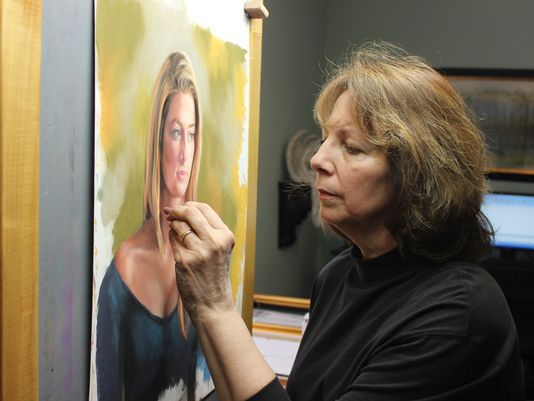PASTELS
PASTELS
I love pastels as a medium. Pastels produce rich, saturated, and often painterly results – so buttery that you risk getting color on the tip of your nose as you peer in close and wonder, “What medium is this?”
Pastels can also produce dry, sketchy, monochrome drawings, such as sepia tone DaVinci style, most often associated with charcoal and sanguine. Generally, when a substrate like paper, sand board, canvas, et al, is saturated with color, it is referred to as a “pastel painting”. When less media, color, or saturation is used, it is referred to as a “pastel drawing” or “pastel sketch”.
What’s this stuff made of?
Pastels are made of the same pigment that is used in oil paints and other media. When I am teaching a new art student about all the different media, I try to simplify it in this way. Think about powdered pigment and put that pigment into an oil base. Now, you have oil paint. Put that same powder into polymers and you have acrylic paint. Use it in gum arabic, and you have watercolors; casein, you have gouache; egg base will produce tempera paint. And, into grease, you will have oil pastels; wax for colored pencils and chalk will produce pastels. This, of course, is grossly understating the manufacturing process of all these great media, but to a new student, I believe it helps them think about and de-mystify the vast array of media that awaits their artistic horizon.
Pastels come in a huge range of qualities and prices. The really cheap, dusty pastels are merely colored chalk, at best, and are sold in large sets for even less than the cost of a Big Mac, fries and a coke (super sized, of course). And, at the other end of the gamut, a decent set of higher-end pastels cost about what you might spend to feed a family of four at the Outback Steakhouse. Yes, I often do relate the cost of most things to food … or tools.
There is so much to write about and discuss when it comes to pastels, like how and who manufactures the different qualities, and why? What papers and boards work best as substrates for pastels? Comparisons of pastel to charcoal pencils, and what in the world is “white charcoal “? Over the next year, I will return often to this topic and, hopefully, answer any questions you might have about pastels.
 In jurying art shows I often see, and most often love, the majority of pastels that are entered. Few artists have ever impressed me like Sue Secord Perrish. Not only is her talent amazing, but it is hard to believe that she has so recently just started drawing. In less than three years, Sue has accomplished a body of work and a bevy of awards that most could not do in a lifetime of study and competition.
In jurying art shows I often see, and most often love, the majority of pastels that are entered. Few artists have ever impressed me like Sue Secord Perrish. Not only is her talent amazing, but it is hard to believe that she has so recently just started drawing. In less than three years, Sue has accomplished a body of work and a bevy of awards that most could not do in a lifetime of study and competition.
As always, I ask artists that I feature to send me a brief bio. After you read Sue’s bio below, please notice her awards and the dates awarded. Sue Secord Perrish is, without a doubt, a rising star in the pastel medium. I am sure she will be just as stellar in any media she chooses.
Biographical Sketch
“I was raised in an environment of creativity. My mother is a very talented watercolor artist, and my father a fine woodworker. Throughout childhood, my creative avenue was the piano. I spent my free time listening to the great composers while attempting to perfect pieces by Chopin and Rachmaninoff. In 1982, I married Robert Perrish, also an accomplished artist, and we settled in Livonia, Michigan where we raised our two children, Kimberly and Stephen.
Over the years, I longed for an artistic creative outlet, but the business of life got in the way. As a result, the creative pursuit became a “some day” kind of thing. During the summer of 2013, I picked up a pencil and began to draw. First came the eye, then the nose, another eye, a mouth. It was as if all my life this ability hid behind a door, waiting to be opened and explored.
In 2014, I began pastel painting. I have always admired the abilities of the pastel artists, taking sticks of vibrant, glorious color and creating beautiful works of art. I greatly admire the paintings of Mary Cassatt, Edouard Manet, Wende Caporale, and Ellen Eagle. I believe there is an intrinsic beauty in every human soul and that our eyes express that beauty in a unique and individual story. As I work on a portrait, I search for that story to try to capture it on the easel.”
Awards and Exhibitions

